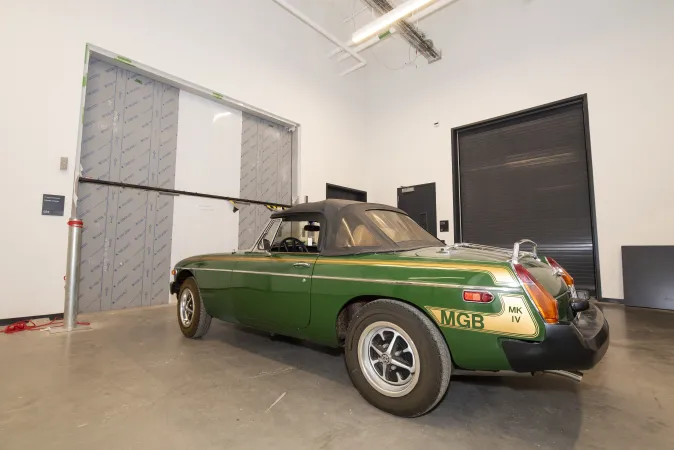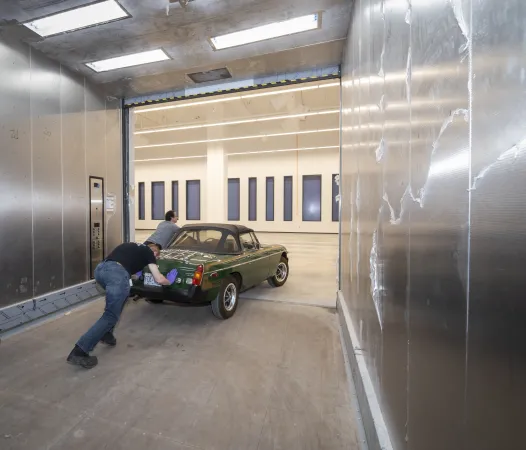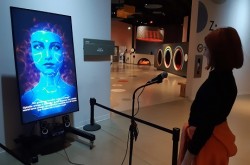Massive elevator lifts Canada’s vintage cars to their new home
A colossal freight elevator at the Ingenium Centre is taking Canada’s science and technology collection to new heights — quite literally.
“The capacity of the elevator is what makes it so special,” explains Simon Aubin, executive director of facilities and capitalization for Ingenium. “It can accommodate over 13,000 kg — that’s almost the equivalent of a five-ton truck.”
The hefty elevator — which measures 3.8 m wide by 6.9 m long and 3.6 m high — is vital for moving the collection’s large artifacts from storage warehouses into their state-of-the-art new home, the Ingenium Centre, located right next to the Canada Science and Technology Museum in Ottawa. This fall, staff have been busy moving the car collection.
“The car collection is going on the third floor, so we needed to ensure all the cars fit in the elevator,” says Aubin. “This entire building was built around the artifacts, and so was the elevator; we built its weight capacity based on the car collection.”

The freight elevator in the new Ingenium Centre has the capacity to lift up to 13,605 kg.
A unique design
In the early planning stages for the Ingenium Centre, Aubin and his team visited other national museums that are equipped with comparable freight elevators.
“The only other elevator that’s similar to ours is in the Shaw Centre, located in downtown Ottawa,” says Aubin. “While it is larger than ours, it doesn’t have the same weight capacity as our elevator.”
Because of Ingenium’s unique requirements, the freight elevator was not an off-the-shelf purchase. Multiple companies were involved in the elevator’s design and build, and KONE Corporation supplied the final product.
“It made for an interesting project,” says Aubin. “Ninety-five percent of the elevator was designed and built in Canada.”
An engineering challenge
The 21 m piston posed a unique challenge for the elevator’s engineering team when it came time to calculate the compression ratio.
“We have this 21-metre piston that’s full of oil,” explains Aubin. “Due to its size and the amount of fluid in the piston and the hydraulic system, the engineer had to calculate — as we put over 13,000 kg into the system — how the auxiliary oil system would be compressed.”
Aubin adds that if the elevator was holding an object that was close to capacity, it would result in too much pressure on the oil in a certain area of the piston. Subsequently, the floor would drop by five centimetres.
“We had to figure out how to keep the elevator from dropping; this is a problem that’s happening at other museums,” says Aubin “We were able to mitigate that with a second-stage hydraulic system that will compensate for the compression ratio of the oil.”
The oversized piston also meant the elevator’s cage had to be reinforced, to avoid a pendulum effect.
“The floor of the cabin also had to be redesigned, so that it wouldn’t bend under the weight of a heavy artifact,” says Aubin. “If the piston would get out of its vertical axis, you would have a problem.”

Inside the shaft of the freight elevator in the Ingenium Centre.
A high water table
When it came time to anchor the elevator deep beneath the Ingenium Centre, the engineering team encountered yet another challenge.
“The water table is high in Ottawa,” explains Aubin. “There was so much water in the casing for the piston that it was generating buoyancy.”
Drilling over 22 m down through shale — which can be very brittle — further complicated the issue.
“When you go down in that rock, water wants to creep in — bringing in sedimentation at the bottom of the hole,” says Aubin. “As a result, the piston wouldn’t go all the way down; we had to bring in a bridge-building company to figure out how to get the sediment out.”
To solve the issue, the team inserted a high-pressure air hose into the muck. The injection of air bubbled the water, changing the sediment to clay. The following day, they were able to position the piston in its proper location, using rock anchors to secure it in place.
Now fully installed, the elevator allows Ingenium staff and movers some flexibility when bringing in the artifact racking system. Aubin adds that some of the supports are over five metres long, and can sit on a diagonal in the elevator. All vehicles in the national collection are expected to be moved over to the Ingenium Centre by the end of November 2019.
“Some of those cars are going to look pretty small in that elevator,” says Aubin.









































































